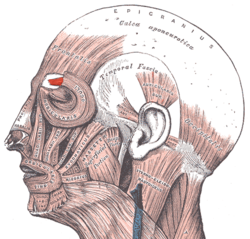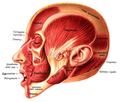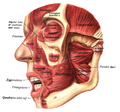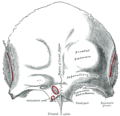| Corrugator supercilii muscle | |
|---|---|
 Anatomical right orbicularis oculi muscle (notice the corrugator muscle at the top) | |
 Corrugator supercilii | |
| Details | |
| Origin | Supraorbital ridge ( Superciliary arches ) |
| Insertion | Forehead skin, near eyebrow |
| Artery | Ophthalmic artery |
| Nerve | Facial nerve |
| Actions | Wrinkles forehead |
| Identifiers | |
| Latin | musculus corrugator supercilii |
| TA98 | A04.1.03.018 |
| TA2 | 2071 |
| FMA | 46794 |
| Anatomical terms of muscle | |
The corrugator supercilii muscle is a small,[1] narrow,[citation needed] pyramidal muscle[1] of the face.[citation needed] It arises from the medial end of the superciliary arch; it inserts into the deep surface of the skin of the eyebrow.
It draws the eyebrow downward and medially, producing the vertical "frowning" wrinkles of the forehead. It may be thought as the principal muscle in the facial expression of suffering. It also shields the eyes from strong sunlight.
YouTube Encyclopedic
-
1/5Views:5 09614 3553 933657583
-
corrugator supercilii
-
Corrugator Supercilii Muscle - Massage Anatomy
-
Muscle Palpation - Orbicularis Oculi & Corrugator Supercilii & Procerus
-
Corrugator Muscles with Sam & Meg
-
Corrugator supercilii muscle anatomy #shorts #youtubeshorts #muscle #anatomy
Transcription
Structure
The corrugator supercilii muscle is located at the medial end of the eyebrow. Its fibers pass laterally and somewhat superiorly from its origin to its insertion.[1]
Origin
It arises from bone at the medial extremity of the superciliary arch.[1]
Insertion
It inserts between the palpebral and orbital portions of the orbicularis oculi muscle. It inserts into the deep surface of the skin of the eyebrow, above the middle of the orbital arch.[citation needed]
Innervation
Motor innervation is provided by the temporal branches of facial nerve (CN VII).[1]
Vasculature
The muscle receives arterial supply from adjacent arteries - mostly from the superficial temporal artery, and the ophthalmic artery.[1]
Relations
It is situated deep to the frontalis muscle (of the occipitofrontalis muscle) and orbicularis oculi muscle, with which it partially blends.[clarification needed][1] Its fibres are situated between the palpebral and orbital portions of the orbicularis oculi muscle.[citation needed]
The supratrochlear nerve passes between this muscle and the frontalis muscle.[2]
Function
The muscle acts in tandem with the orbicularis oculi muscle. The corrugator supercilii muscle acts upon the skin of the forehead superior to the middle of the supraorbital margin,[1] drawing the eyebrow inferomedially to produce vertical wrinkles of the forehead[3] just superior to the nose.[1] It is the "frowning" muscle, and may be regarded as the principal muscle in the expression of suffering.[4] It also contracts to prevent high sun glare,[4] pulling the eyebrows toward the bridge of the nose, making a roof over the area above the middle corner of the eye and typical forehead furrows[4] to shield the eye from excessively bright sunlight.[1]
Clinical significance
The muscle is sometimes surgically severed or paralysed with botulinum toxin as a preventive treatment for some types of migraine or for aesthetic reasons.[5]
Etymology
The name corrugator supercilii comes from Latin, and means wrinkler of the eyebrows.
Additional images
-
Corrugator supercilii seen from the inside.
-
-
-
-
Position of corrugator supercilii muscle (red)
-
Outer surface of frontal bone.
-
Visible on upper portion of face.
References
![]() This article incorporates text in the public domain from page 907 of the 20th edition of Gray's Anatomy (1918)
This article incorporates text in the public domain from page 907 of the 20th edition of Gray's Anatomy (1918)
- ^ a b c d e f g h i j Standring, Susan (2020). Gray's Anatomy: The Anatomical Basis of Clinical Practice (42th ed.). New York. p. 624. ISBN 978-0-7020-7707-4. OCLC 1201341621.
{{cite book}}: CS1 maint: location missing publisher (link) - ^ Lasaosa, S. Santos; Pérez, M. L. Cuadrado; Peral, A. L. Guerrero; Villanueva, M. Huerta; Porta-Etessam, J.; Pozo-Rosich, P.; Pareja, J. A. (2017-06-01). "Consensus recommendations for anaesthetic peripheral nerve block". Neurología (English Edition). 32 (5): 316–330. doi:10.1016/j.nrleng.2016.04.002. ISSN 2173-5808.
- ^ Cattaneo, Luigi; Pavesi, Giovanni (2014-01-01). "The facial motor system". Neuroscience & Biobehavioral Reviews. 38: 135–159. doi:10.1016/j.neubiorev.2013.11.002. ISSN 0149-7634. PMID 24239732. S2CID 207090623 – via ScienceDirect.
- ^ a b c "eye, human."Encyclopædia Britannica from Encyclopædia Britannica 2006 Ultimate Reference Suite DVD 2009
- ^ de Ru JA, Schellekens PP, Lohuis PJ (2011). "Corrugator supercilii transection for headache emanating from the frontal region: a clinical evaluation of ten patients". J Neural Transm (Vienna). 118 (11): 1571–4. doi:10.1007/s00702-011-0654-1. PMID 21597942. S2CID 23829349.
{{cite journal}}: CS1 maint: multiple names: authors list (link)







